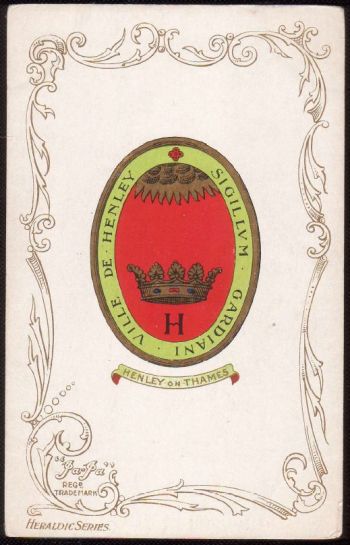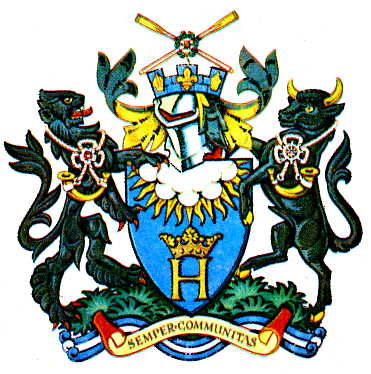Henley-on-Thames
| Heraldry of the World Civic heraldry of the United Kingdom |
HENLEY-ON-THAMES
Incorporated into : 1974 South Oxfordshire
Origin/meaning
The borough did not use arms, only the above seal.
The present Henly Town Council uses the arms below:
These arms were granted on ??
The shield is based upon the ancient seal that has been used by the Town Guardians of Henley and then by Henley Borough Council. The clouds from which radiate the rays of the sun was the royal badge of Edward III and has been used on Henley's seal since 1624.
The mural crown symbolises the town's borough status which extended from 1241 until 1974. It is charged with a fleur de lys, the symbol of St. Mary the Virgin to whom Henley's Parish Church is dedicated. The bishops' mitres, suggests the two episcopal benefactors of the town, Archbishop Laud and Bishop Longland. The Diamond Challenge Sculls denotes Henley's identification with the sport of rowing in general, and with the Royal Regatta in particular.
The lion is derived from that depicted on the town's seal from 1306, and the ox to denotes Henley's historic links with Oxford and Oxfordshire. The bugle horn hanging from a bowed string, is the regimental badge of the Ox and Bucks Light Infantry, with whom Henley men fought and fell in two world wars. The Tudor Rose is a badge of James I, who is traditionally treated as the founder of Henley Grammar School. The rose also denotes the rent that was annually paid to the crown for the Manor of Phyllis Court. The Catherine Wheel, the symbol of St. Catherine, who is 'the favourite saint of Henley' according to the historian Burn. The Bridgemen's Chantry was formerly in a chapel within Henley's Parish Church, dedicated to St. Catherine and endowed by the town with a considerable rental. The compartment denotes the town's situation in the region where the grass-covered Chilterns sweep down to the Thames.
The badge is a re-arrangement of the charges shown on the shield. A crowned letter H is shown within an oval surrounded by clouds from which radiate the rays of the sun.
Literature : Image and information provided by Laurence Jones.

